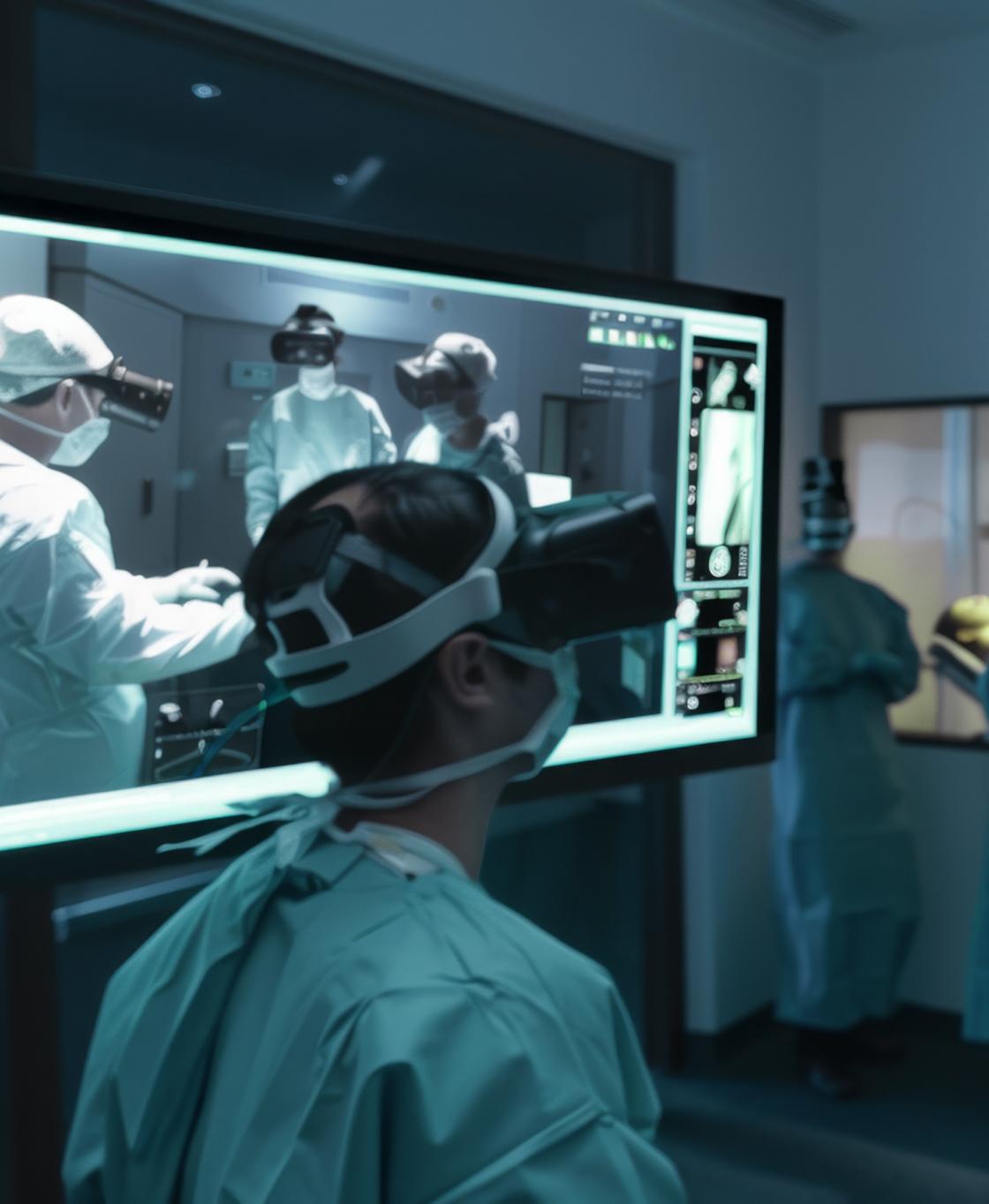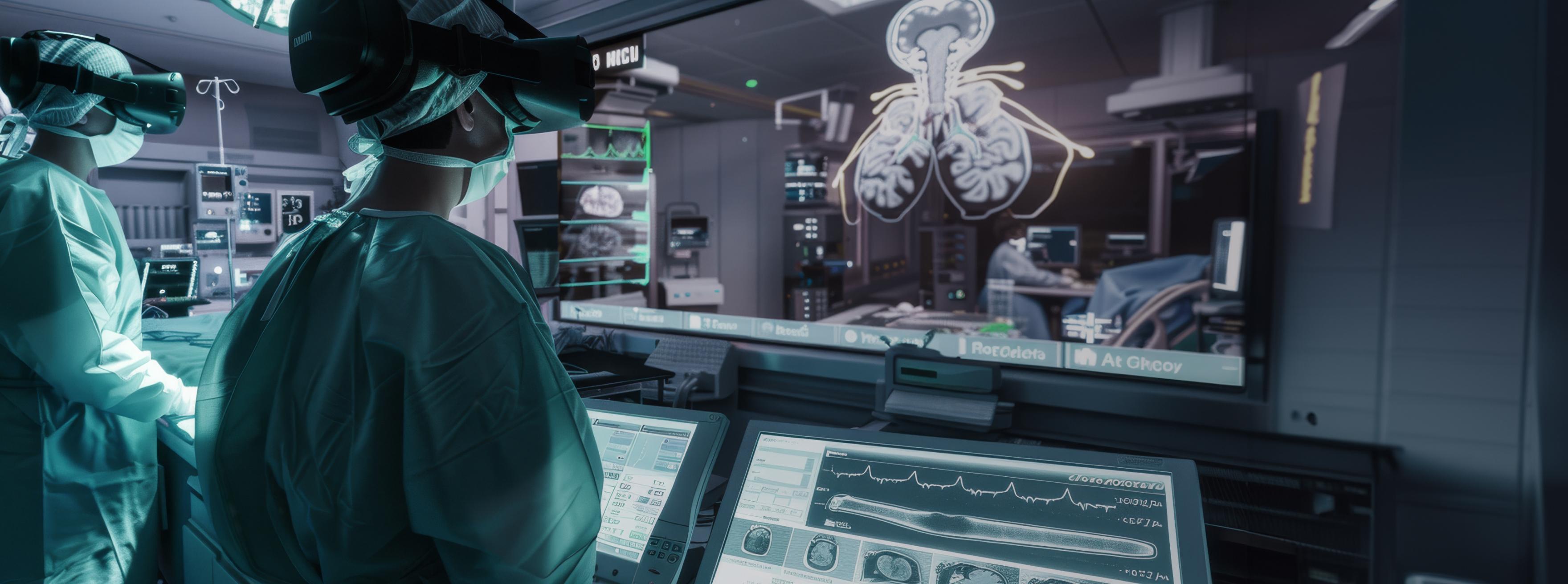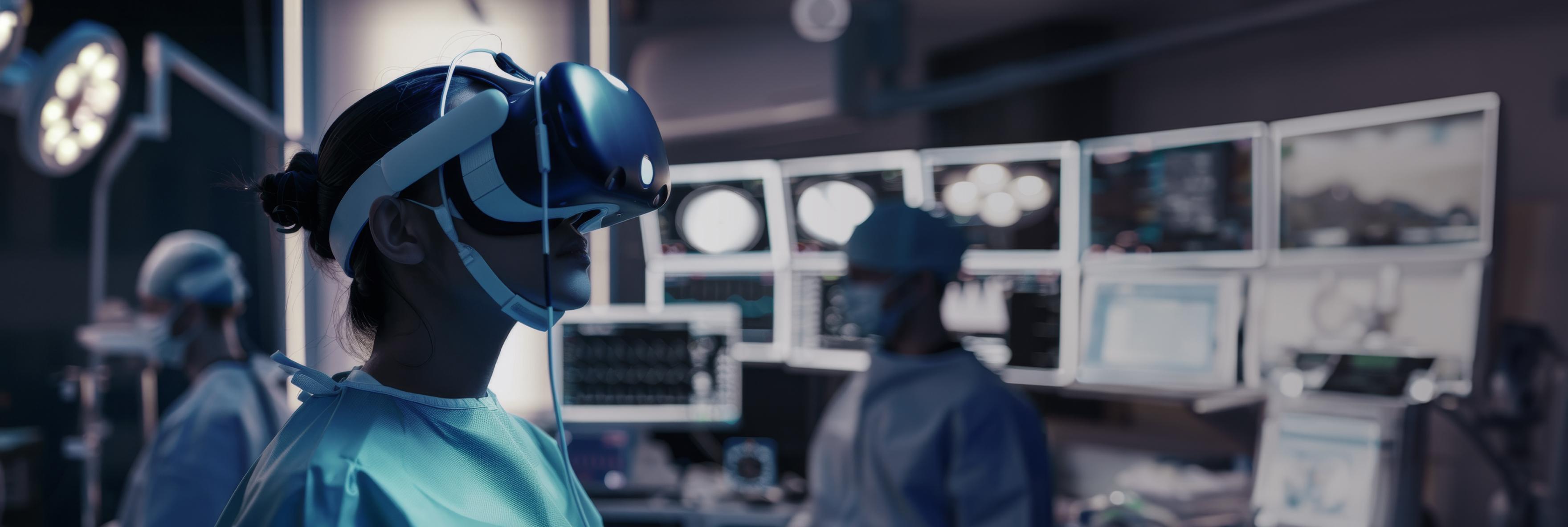Virtual reality for surgery training: A deep dive into cutting-edge capabilities
VR has become the go-to tool for both aspiring and experienced surgeons, providing a risk-free, immersive environment to refine their skills and improve patient outcomes. It's no longer a novelty — it's the new standard in medical training.
Whether you’re planning a VR project, exploring VR solutions for development, or simply researching VR’s impact, we’ve got you covered. Backed by decades of hands-on experience, this guide is packed with practical insights and expert perspectives tailored just for you.

Virtual operating rooms teach the real deal
Until recently, medical professionals training for surgery had one option: first train with cadavers and then observe and assist experienced surgeons in the operating room.
Today’s surgeons-in-training aren’t limited to traditional learning techniques.
With the technological leaps in virtual reality software development, medical students can participate in immersive and interactive VR simulations that help them understand what it feels like to operate on a patient before they even set foot inside an operating room. VR also helps already accredited surgeons train new procedures on 3D models.

A quick look at the industry that learns fast
Medical schools have been closely watching the impact of virtual reality in surgery training, with consistently positive results. The studies show that medical students trained with VR simulations completed a standard orthopedic procedure faster (P < 0.05) and with fewer redirections (P = 0.05) compared to traditionally trained students.
Similarly, a randomized controlled trial comparing VR training to video instruction revealed that VR training resulted in higher rates of accurate procedure completion, reduced time, and fewer errors.
These findings align with the rapid expansion of VR’s healthcare market, which is growing with a 35 percent CAGR, and expectations around virtual reality in surgical training have followed suit. Leading surgical virtual reality companies, like Osso VR, have raised hundreds of millions in total funding due to the increasing perception, corroborated by evidence, that VR use in surgery training is a cost-effective way to yield better medical results.
The trend is expected to gain further momentum following Apple’s launch of the Vision Pro premium headset in May 2023, which has opened the door to even more investment in the VR industry.
VR brings unique benefits to the operation table
Virtual reality technologies complement existing teaching methods and, in some cases, enable modes of learning that wouldn’t otherwise be possible. VR’s safety, accessibility, and cost-effectiveness in training surgeons set the stage for surefire returns on investment for any medical institution that wishes to stay ahead of modern surgical education techniques.
Realistic surgical simulations
VR provides highly realistic, immersive virtual environments for surgeons to practice in virtual surgical theaters that accurately mimic real life. That includes hyper-realistic patient anatomies, operating room equipment, and surgical techniques.
Mistake-friendly environments
Virtual reality eliminates the burden of mistakes, letting upcoming surgeons practice at will in safe virtual spaces. Trainees in VR are free to experiment with different approaches, techniques, and strategies to learn from their errors.
Long-term cost-effectiveness
The upfront cost of VR technology might look intimidating (usually between $25,000 and $250,000 with headsets for a well-rounded app), but it’s worth the investment in the long term. Many physical resources in traditional surgical training are single-use or suffer from supply bottlenecks, an issue entirely sidestepped in virtual reality with its reusable, scalable, and easily shareable alternatives.
Procedural variety and complexity
Certain conditions, like cases of conjoined twins, are far too rare and may demand decades from doctors to attain surgical mastery via traditional training. VR lets surgeons experience various scenarios and build a comprehensive skill set regardless of how frequently they encounter those cases in real life.
Remote and collaborative learning
Through VR surgery apps like Medicalholodeck’s TeamXR, surgeons-in-training can connect with colleagues and mentors across the globe to receive real-time guidance and feedback. Additionally, VR enables virtual team-based surgical procedures, enhancing knowledge exchange and collaboration across institutions.
Essential features for VR training apps for surgeons
Developing VR solutions can feel overwhelming, with countless features and tight deadlines. But you don’t need to tackle everything at once. We recommend starting with a minimum viable product (MVP) that focuses on the essential features. Once you’ve perfected this, it’s easy to build on it, enhancing the user experience step by step.
Not sure where to start? For VR surgery training apps, accurate anatomy models and real-time feedback are great foundations. If you’re looking for tailored recommendations, our consultants are here to guide you every step of the way.
Realistically models human anatomy and surgical tools, creating immersive environments that closely mimic real-world settings.
Enables interaction with a 3D environment with the help of VR headsets.
Reproduces tissue tension, oozing or bleeding processes, surfaces of organs and surgical tools.
Provides access to virtual training sessions and modules, complete with step-by-step procedures and tutorials about emergency scenarios, pre- and post-operative care, and instrument handling.
Leverages artificial intelligence models to analyze trainee performance, tracking accuracy, identifying gaps, and tailoring training content to close those gaps.
Tracks individual and team metrics, allowing for benchmarking and monitoring of process and performance parameters in real time.
Introduces skill levels, achievement badges, and leaderboards to motivate trainees, with progression unlocked as specific training milestones are reached.
Crucial for planning a product targeted at global markets. It also helps improve training accessibility and achieve better learning outcomes for multinational groups and teams.
Strong user authentication mechanisms and secure data storage to avoid theft and misuse of sensitive user data, unique and patented training materials.
Voice communication provides extra convenience with hand-free control over the devices. It also contributes to realism, as learners can interact with assistants.
Facilitates reviewing surgical training sessions or specific segments, giving a deeper understanding and analysis of techniques and decision-making processes.
Provides step-by-step instructions through visual cues or advanced virtual assistants, helping trainees navigate procedures clearly and easily.
Ensures flexibility, supporting multiple VR headsets and hardware options to meet various user preferences.
Revolutionary solutions, right? Still, they are already a reality.
Outstanding success stories of virtual reality in surgery training
VR surgical training platforms are on the path to becoming indispensable to any modern medical university. Successful platforms commonly partner with traditional learning institutions to improve their products and understand the detailed needs of students looking for immersive virtual training sessions.
Precision OS is a leading VR surgical training company specializing in orthopedic training. With virtual reality curricula in a wide range of interactive surgical practices, the company’s immersive surgical simulations supply the residency programs of many universities in North America and beyond.
FundamentalVR boasts an exact haptic solution that improves surgical accuracy by up to 44 percent versus traditional methods. Their platform and online tools also allow for much customization: Companies can tweak existing virtual reality simulations as necessary so that students can practice unique cases in complex specializations.
VirtaMed has been on the surgical simulations market for longer than any popular headset today. The company is a mainstay of healthcare VR with tailor-made scenarios that individually cover orthopedics, obstetrics, gynecology, urology, laparoscopy, and arthroscopy techniques. It's sought after due to its unique lower body specialty solutions.

Want to achieve similar success?
Vention's VR engineers are here to turn your vision into reality.
A success story by Vention: Mixed reality app development
Vention developed a mixed-reality app that transforms scans into custom 3D models of a patient’s anatomical structures to maximize the utility of CT and MRI scans.
Medical professionals can interact with these 3D models, rotate them, and explore tissue layers in detail. Surgeons could also perform AR-assisted surgeries, visualize the 3D models, expertly navigate risky areas, and improve surgery outcomes.
Custom development of a surgical training VR app, step by step
VR for surgery training is a niche field. It focuses on surgery and varies significantly based on medical specializations, such as ophthalmology, gynecology, orthopedics, and plastic surgery.
You may find that the market-available apps are not tailored precisely to your needs. However, this doesn’t mean you can't access the benefits of VR training apps — it simply implies custom development might be the right option for you.
At Vention, our experts follow a tried-and-tested outline that ensures the solution’s quality while still leaving space for future improvement and scaling.
Here are our primary steps to developing a world-class VR surgery app:
Discovery
Through a series of interviews with your stakeholders and a thorough analysis of VR apps on the market, our consultants develop a comprehensive requirements specification outlining your current state and desired situation:
-
Target audience (think medical students, surgical residents, practicing surgeons, or a mix of the groups)
-
Target market niche and gaps in competitors’ offerings — if you develop a product for commercial distribution rather than a tool for internal use
-
Medical specializations and procedures the app will cover
-
Key and auxiliary features
-
Requirements for VR headsets compatibility: cross-platform or optimized for specific devices like Oculus or HTC Vive
UX design
Our UX designers help you clearly understand the goals and journeys of each user group within your app, covering everything from login and selecting a training module to performance review and session playback. This phase also includes the creation of VR training scenarios.
Our team also handles interaction design with the future app, e.g., motion control.
PoC development
Our VR experts can first deliver a proof of concept (PoC) to help you determine the app idea's feasibility.
For example, we can focus on just one surgical procedure — say, laparoscopic suturing. Instead of creating all the planned hyper-realistic anatomical and environmental 3D models, our designers can create simplified yet accurate models of the abdomen blood vessel, laparoscopic instrument, and operating table.
We follow a similar approach for other development aspects: Our engineers implement basic (rather than advanced) interaction mechanisms and analytics. If the PoC proves itself and everything works as expected, we then proceed with full-scale development.
Architecture design and tech stack selection
Our solution engineers deliver an architecture that is easy to scale, maintain, and update. It also meets the processing speed requirements, which is crucial for smooth and realistic 3D model rendering and real-time feedback and analytics.
To achieve the goals mentioned above and ensure compatibility with devices and the needed third-party systems, we also recommend the optimal stack of technologies.
Development
Our VR team creates realistic 3D models of anatomical structures, surgical instruments, environment, and surgeon avatars for multi-trainee modes — to cover all the planned training procedures.
Our backend engineers deliver ETL pipelines, data processing systems, storage components, analytics, and security controls. In parallel, our frontend team implements UI elements: menus, interaction and feedback mechanisms, and scripts for virtual reality simulations.
Integration
Our team integrates SDKs and implements APIs to connect your VR app with:
-
Hardware: VR headsets and controllers
-
Internal systems like learning management systems, medical imaging libraries, data storage
-
External services like AI, voice recognition, or security cloud services
Solution testing
Our skilled QA team employs a combination of proven manual and automated testing techniques to uncover any vulnerability in your VR app. This approach ensures your end-user immersive training experience remains intuitive and functional across various devices and systems — under normal and high-load conditions alike.
Refinement
Even post-launch, we can remain engaged to help you achieve your KPIs by analyzing app usage data and gathering user feedback. We can continuously refine and enhance your solution, ensuring it stays ahead of the curve and consistently outperforms expectations.
VR’s technology stack
Vention relies on the trusted technology stack to help you develop your VR training app swiftly and without compromising quality.
VR engines
Unity 3D
Unreal Engine
3D modeling and animation
Autodesk MAYA
Blender
Autodesk 3Ds Max
3Dcoat
Zbrush
TopoGun
VR headsets
Oculus Rift
Oculus Quest 2
HTC Vive
Windows Mixed Reality
Samsung Gear
Meta Quest 3
Microsoft HoloLens
VR tools/SDKs
Meta XR SDK
XR Interaction Toolkit
About Vention
Combining rich experience in virtual reality and healthcare domains, our team would gladly provide any assistance you need in your VR training app for surgery. Be it consulting or implementation, Vention’s mission is to bring you confidence, engineering peace of mind, and ultimate success.





